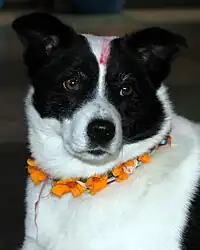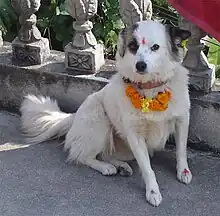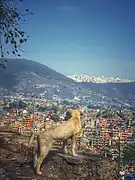| Kukur Tihar | |
|---|---|
 Dog bedecked with flower garlands | |
| Official name | कुकुर तिहार |
| Also called | Festival of Dogs |
| Type | Religious |
| Celebrations | Honouring dogs |
| Observances | Prayers and religious rituals |
| Date | Kārtika māsa kṛṣṇa pakṣa chaturdashi tithi |
| 2023 date | 12 November 2023 |
| Frequency | Annual |
Kukur Tihar (also called Narak Chaturdashi, Nepali: कुकुर तिहार) is an annual Hindu festival originating from Nepal which falls on the second day of the festival of Tihar (around October or November). On this day, people worship dogs to please Yama, the god of death, as they are considered to be his messengers. Dogs are decorated with tilaka and wear flower garlands around their necks. Worshippers offer them various foods including meat, milk, eggs, and dog food. It is considered a sin if someone acts disrespectfully to a dog on this day.
Kukur Tihar is also celebrated worldwide by the Nepalese diaspora.
Background

Tihar is a five-day-long Hindu festival originating from Nepal; it is the second-largest festival in the country, after Dashain.[1][2][3] Kukur Tihar is celebrated on the second day of Tihar.[2][4] During the festival of Tihar, many animals including cows and crows are also worshipped.[5][6]
In the ancient Sanskrit epic Mahabharata, the five Pandavas on their way to heaven are accompanied by a dog.[7] The five Pandavas with their wife Draupadi and brothers climb the Himalayas; all of them except Yudhishthira and his dog perishing along the way.[8] Then Yudhishthira meets Indra, King of the gods, who welcomes him to heaven but tells him he has to leave his dog behind.[8][9] Yudhishthira refuses to enter heaven without his dog and says he will go back to earth.[8][10][11] The dog disappears and it is replaced by Yama, the god of death; Indra is impressed by his actions and then his righteousness opens the gates of heaven for Yudhishthira.[8][9]
In Hindu mythology, Yama has two dogs—Shyama and Sharvara—who guard the door of hell.[12] Nepali Hindus believe that by worshipping dogs they start to see death positively, because a dog follows them in their final journey.[13] They hope that dogs will guard them against the torture in hell.[13] Dogs are considered to be a companion of Yama and to please him, dogs are worshipped.[2][14]
According to ABC Science, dogs might have been first domesticated in Nepal and Mongolia.[15]
Celebrations
Hindu festival dates The Hindu calendar is lunisolar but most festival dates are specified using the lunar portion of the calendar. A lunar day is uniquely identified by three calendar elements: māsa (lunar month), pakṣa (lunar fortnight) and tithi (lunar day). Furthermore, when specifying the masa, one of two traditions are applicable, viz. amānta / pūrṇimānta. If a festival falls in the waning phase of the moon, these two traditions identify the same lunar day as falling in two different (but successive) masa. A lunar year is shorter than a solar year by about eleven days. As a result, most Hindu festivals occur on different days in successive years on the Gregorian calendar. | |
Tihar is celebrated around October or November every year.[16] During the festival, dogs are worshipped, bathed, and decorated with tilaka, which is made from kumkuma or gulal powders with rice and yoghurt.[13][17] Flower garlands are draped around their necks and they are offered food including meat, milk, eggs, and dog food.[2] Police dogs and stray dogs are also honoured.[18]Kukur Tihar also celebrates the relationship between dogs and humans.[19] It is considered a sin if someone behaves disrespectfully to a dog on this day.[20]
Reception
After the April 2015 Nepal earthquake, Animal Nepal used the occasion of the festival to promote awareness about dogs who became homeless.[18] The Kathmandu Post reported that people were buying foreign breeds of dogs which left the local dogs in the streets.[21]
Kukur Tihar spread around Mexico in 2016 to make people aware of respecting animals.[22] Special Broadcasting Service reported that many Nepalis in Australia were also celebrating the festival.[23][24] In 2008. Asian Art in London celebrated the festival by creating a dog walk charity event.[25] Also in 2016, Kathmandu Metropolitan City with the help of Humane Society International and Jane Goodall Institute Nepal created a program to "humanely manage urban dog population".[26] An educational assessment done by International Companion Animal Management Coalition (ICAM Coalition) found that dogs in the capital of Nepal were "generally healthy and accepted by the community".[27]
In 2018, a dog named Kushal was named "The Best Dog of the Year" by the Nepal Police on the occasion of the festival after the dog helped discover the murderer of a 10-year-old girl.[28]
After the Chinese Lychee and Dog Meat Festival, in which festival-goers eat dog meat and lychees, garnered international outrage, One Green Planet described Kukur Tihar as "[it] will restore your faith in humanity".[29] People on social media contrasted the Chinese festival with Kukur Tihar and The Dodo reported that "[it gave] heartbroken dog lovers a reason to feel hopeful again".[30] In a 2016 newspaper article, the President of Animal Nepal appealed to Nepalis "to take a pledge this Kukur Tihar, to not just worship your pets on this day but to do the right thing for them all year round. Unchain and uncage your dogs, learn to interact with them, take them for walks, understand their feelings, …"[31] A 2007 BBC photo essay also pointed out the need to improve the treatment of Nepali dogs which, "during the rest of the year, are not generally well treated..."[32]
Gallery
 Dog bedecked with flower garlands
Dog bedecked with flower garlands Kukur Tihar is celebrated on the second day of five–day Tihar festival, a day before Dipawali.
Kukur Tihar is celebrated on the second day of five–day Tihar festival, a day before Dipawali. The feet and forehead of dog are adorned with a red tika
The feet and forehead of dog are adorned with a red tika Alongside pet dogs, stray dogs are also worshipped on this day.
Alongside pet dogs, stray dogs are also worshipped on this day.
See also
| Part of a series on the |
| Culture of Nepal |
|---|
 |
| Society |
| Topics |
| Symbols |
References
- ↑ "Market in border area bustling". The Himalayan Times. 9 November 2020. Retrieved 10 November 2020.
- 1 2 3 4 "Nepal festival celebrates 'day of the dogs'". BBC. 6 November 2018. Archived from the original on 27 October 2020. Retrieved 27 October 2020.
- ↑ Prasain, Krishana (21 October 2020). "Nepal's biggest festival Dashain fails to lift the market mood, buyers and sellers say". The Kathmandu Post. Archived from the original on 10 November 2020. Retrieved 10 November 2020.
- ↑ Devleesschauwer, Brecht; et al. (12 February 2016). "Epidemiology, Impact and Control of Rabies in Nepal: A Systematic Review". PLOS Neglected Tropical Diseases. 10 (2): e0004461. doi:10.1371/journal.pntd.0004461. ISSN 1935-2735. PMC 4752342. PMID 26871689.
- ↑ Kelly, Erin (5 October 2015). "In Nepal, Every Dog Has Its Day. Literally". All That's Interesting. Archived from the original on 27 October 2020. Retrieved 27 October 2020.
- ↑ Devkota, Mahima (3 November 2021). "Why do we worship crows and dogs?". The Rising Nepal. Archived from the original on 3 November 2021. Retrieved 21 November 2021.
- ↑ Shahani, Shradha (22 October 2019). "In Nepal, Diwali is a time to worship the dogs". Condé Nast Traveller. Archived from the original on 27 October 2020. Retrieved 27 October 2020.
- 1 2 3 4 Vajpeyi, Ananya (29 June 2019). "Epic lessons for Kali Yuga: Rereading the 'Mahabharata' in our contemporary moment". The Hindu. ISSN 0971-751X. Archived from the original on 27 October 2020. Retrieved 27 October 2020.
- 1 2 Singh, Sudeshna (8 April 2020). "Interested in the Mahabharata? Know how the Pandavas died". Times Now. Archived from the original on 27 October 2020. Retrieved 27 October 2020.
- ↑ Das, Gitanjali (6 September 2020). "Explained: After Modi's push, a look at the several dog breeds native to India". The Indian Express. Archived from the original on 27 October 2020. Retrieved 27 October 2020.
- ↑ "Day of the Dog: A day before Diwali, Nepal celebrates 'dog puja festival' with fervour – See pics". Times Now. 7 November 2018. Archived from the original on 27 October 2020. Retrieved 27 October 2020.
- ↑ "Dogs worshipped on Kukur Tihar". The Kathmandu Post. 10 November 2015. Archived from the original on 27 October 2020. Retrieved 27 October 2020.
- 1 2 3 Marak, Queenbala; Chaudhuri, Sarit K. (28 February 2020). The Cultural Heritage of Meghalaya. Routledge. ISBN 978-1-000-07182-5. Archived from the original on 28 October 2020. Retrieved 28 October 2020.
- ↑ "Kukur Tihar, Laxmi Puja observed; Bhai Tika tomorrow". The Himalayan Times. 28 October 2019. Archived from the original on 27 October 2020. Retrieved 27 October 2020.
- ↑ Images, Timothy Allen/Getty (20 October 2015). "Dogs may have been first domesticated in Nepal and Mongolia". ABC News. Australian Broadcasting Corporation. Archived from the original on 27 October 2020. Retrieved 27 October 2020.
- ↑ Dahal, Phanindra (2 October 2020). "Covid: God may punish Nepal for cancelling rites, religious leaders warn". BBC. Archived from the original on 28 October 2020. Retrieved 28 October 2020.
- ↑ "Did you know there is a dog puja festival in Nepal on Choti Diwali day?". The Indian Express. 18 October 2017. Archived from the original on 27 October 2020. Retrieved 27 October 2020.
- 1 2 "Dogs in Nepal enjoy treats, affection". Gulf Times. 30 October 2016. Archived from the original on 14 November 2016. Retrieved 27 October 2020.
- ↑ Whitehead, Joanna (8 November 2018). "This Nepalese festival has an entire day devoted to celebrating dogs". The i. Archived from the original on 27 October 2020. Retrieved 28 October 2020.
- ↑ Mayol, Taylor (20 October 2015). "All Dogs Go to Heaven … in Nepal". OZY. Archived from the original on 27 October 2020. Retrieved 27 October 2020.
- ↑ "Kukur Puja for rescued dogs". The Kathmandu Post. Archived from the original on 28 October 2020. Retrieved 28 October 2020.
- ↑ "Mexico adopts Kukur Tihar". Nepali Times. 12 November 2018. Archived from the original on 27 October 2020. Retrieved 27 October 2020.
- ↑ "Every dog has its 'favourite' day in Nepal". SBS. Archived from the original on 27 October 2020. Retrieved 27 October 2020.
- ↑ ""Happy Dog Day": Nepalis in Australia celebrate their favorite companion for a Hindu festival". SBS. Archived from the original on 27 October 2020. Retrieved 27 October 2020.
- ↑ Moore, Susan (1 November 2008). "Asian art market: Asian Art in London offers up an extraordinary range of works from every corner of the continent. Susan Moore selects some highlights". Apollo. 168 (559): 108–110. Archived from the original on 28 October 2020. Retrieved 28 October 2020.
- ↑ "Nepal's First Metropolitan Dog Management Program – "Manumitra" – Launched in Kathmandu". Humane Society International. 20 April 2016. Archived from the original on 27 October 2020. Retrieved 27 October 2020.
- ↑ Kartal, Tamara (29 July 2019). "Manu Mitra: an example of community engagement in Kathmandu, Nepal". ICAM. Archived from the original on 27 October 2020. Retrieved 27 October 2020.
- ↑ "'Special 78' sniff out murderers for Nepal Police". The Kathmandu Post. Archived from the original on 28 October 2020. Retrieved 28 October 2020.
- ↑ "Mad About the Yulin Dog Meat Festival? This Festival in Nepal Will Restore Your Faith in Humanity". One Green Planet. 29 June 2015. Archived from the original on 27 October 2020. Retrieved 27 October 2020.
- ↑ Schweig, Sarah V. (26 June 2015). "Dogs Thanked For Friendship And Loyalty in Most Beautiful Festival". The Dodo. Archived from the original on 27 October 2020. Retrieved 28 October 2020.
- ↑ "The essence of Kukur Tihar". The Himalayan Times. 29 October 2016. Archived from the original on 27 October 2020. Retrieved 27 October 2020.
- ↑ "In pictures: Nepal dogs honoured". BBC. 8 November 2007. Archived from the original on 28 October 2020. Retrieved 28 October 2020.